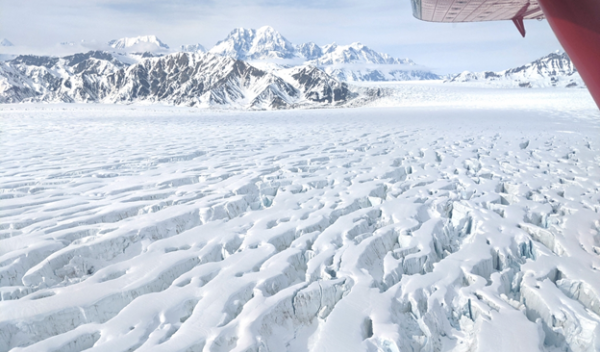A detailed “body scan” of Malaspina Glacier, one of Alaska’s most iconic glaciers, revealed that its bulk lies below sea level and is undercut by channels that may allow ocean water to gain access should its coastal barrier erode. That makes the glacier vulnerable to seawater intrusion and may cause it to retreat faster than predicted.
The U.S. National Science Foundation-supported findings, published by University of Arizona researchers in the Journal of Geophysical Research, underscore the fragility of a large glacial system that could lead to the loss of a significant volume of ice and could contribute a measurable volume to global sea-level rise.
“The loss of this glacier would likely be the largest loss of ice from an Alaskan glacier in this century,” said lead study author Brandon Tober.
The area in front of Malaspina Glacier, a permafrost zone with pure ice beneath the surface, is “wasting away” in the face of rising global temperatures. Permafrost refers to ground that remains frozen for two or more years.
“As this coastal barrier erodes and gives way to large lagoons, primarily through the collapse of ice cliffs, ocean water may eventually gain access to the glacier,” Tober said. “Once it gets to the front of the glacier, it may melt the ice even faster and initiate the glacier’s retreat.”
An expansive ice sheet on the shore of southeast Alaska, Malaspina is the world’s largest piedmont glacier, a glacier that flows from steep mountains onto a broad plain, essentially forming a “pancake of ice” that spills out onto the broad coastal plain from the St. Elias Mountains.
A thin land barrier separates the glacier from the waters of the Gulf of Alaska. To gain a better idea of Malaspina’s future, the researchers needed to get a detailed body scan of its shape and thickness. To do that, they used the Arizona Radio Echo Sounder, or ARES, an instrument designed and built by a team led by Jack Holt, one of the paper’s co-authors.
The measurements revealed that Malaspina Glacier sits largely below sea level and is cut by several channels at its bed that extend at least 21 miles from where the glacier meets the shore toward its source in the St. Elias Mountains.
The combination of the glacier’s location and the continued loss of its coastal barrier may provide pathways for ocean waters to access large areas of Malaspina’s bed along these channels.
Assuming that leads to large-scale shedding of ice mass and the glacier’s retreat, the researchers conclude that Malaspina has the potential to contribute 134 cubic miles (560 cubic kilometers) of ice to the ocean. In other words, Malaspina alone could raise global sea level by 1.4 millimeters.
Source: News Release

